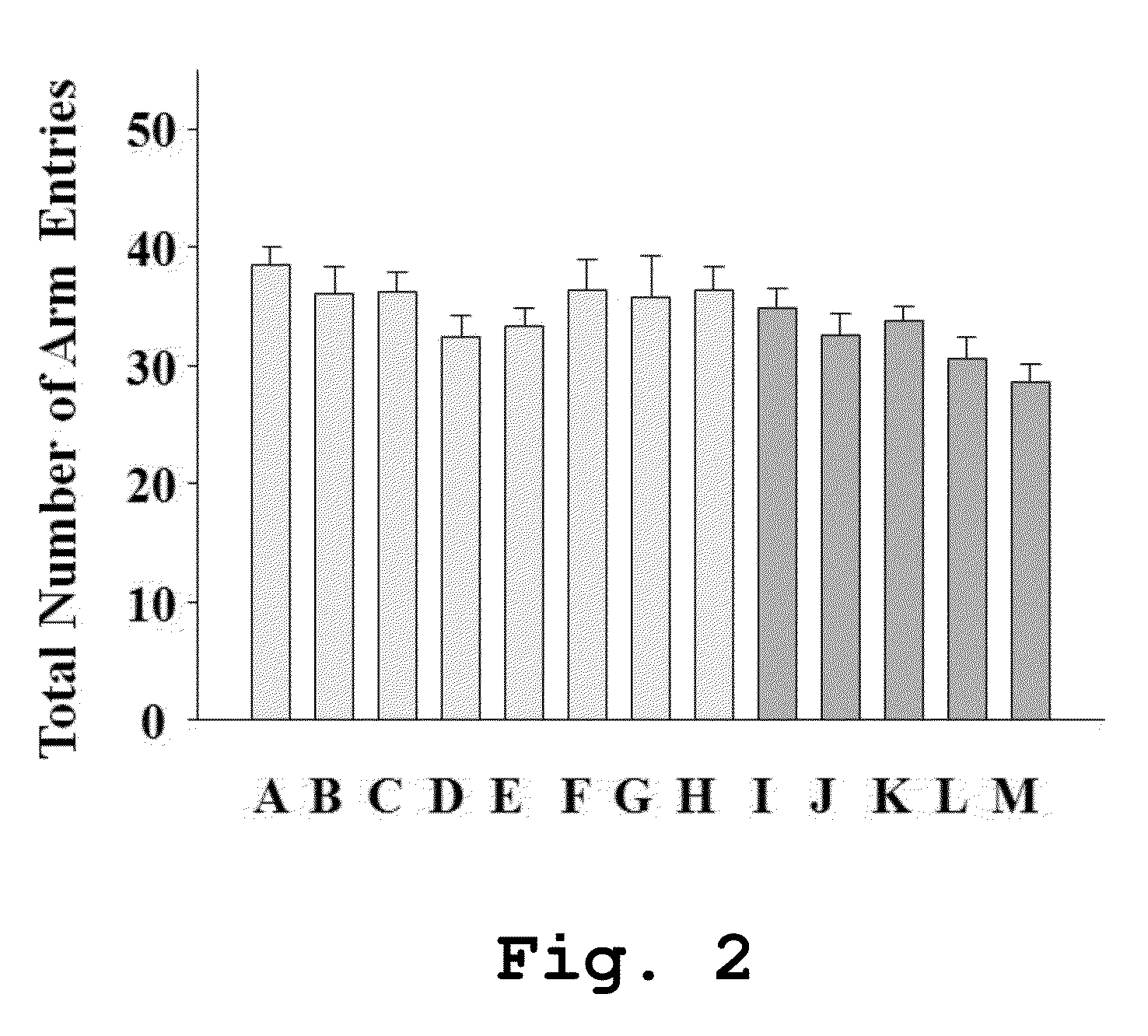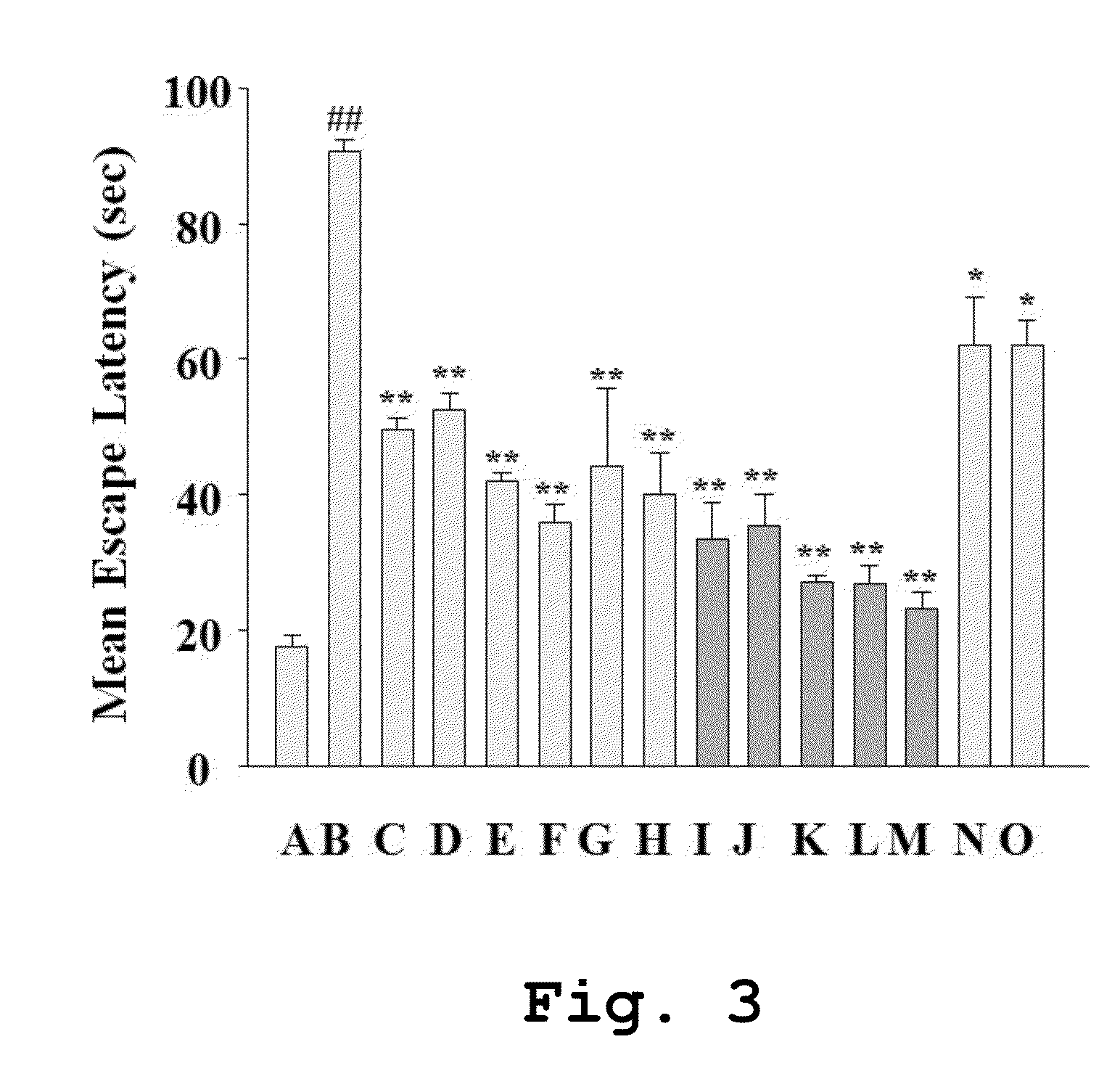Cosmetic composition containing a cypress essential oil complex as an active ingredient for enhancing memory and improving cognitive dysfunction
a technology of cypress essential oil and cypress essential oil, which is applied in the direction of hair cosmetics, drug compositions, biocide, etc., can solve the problems of increasing the burden on patients with dementia, affecting the quality of life of patients, so as to improve the effect of memory, prevent cognitive dysfunction, and improve the effect of therapeutic
- Summary
- Abstract
- Description
- Claims
- Application Information
AI Technical Summary
Benefits of technology
Problems solved by technology
Method used
Image
Examples
experimental example 2
Morris Water-Maze Test
[0045]In a Morris water-maze test, the essential oils of the present invention were examined for influence on spatial learning and short and long-term memory recovery. The maze set up contained a round water pool (stainless steel, 45 cm deep with a diameter of 120 cm), and a hidden rescue platform (30 cm high with diameter of 10 cm). The pool was filled with water (22±2° C.) to a height 2 cm higher than the platform, so that the mouse was rescued when it had a seat on the platform. Because the water-maze test is designed to examine the ability of the subject to search for the platform depending on the memory of surrounding environments, no changes were made in the surrounding environments during the experiment period. When the subject stayed for 20 sec or longer on the platform, the time to reach the platform was recorded as escape latency. Escape latency values of the measurements obtained in daily three test rounds for four days were averaged (mean escape lat...
experimental example 3
Passive Avoidance Test
[0049]A passive avoidance test was performed in a training chamber which was divided into two compartments (each 25 cm in width and 20 cm in length with a height of 20 cm) separated by a guillotine door: one compartment was lighted by an overhead light while the other remained dark. In the dark compartment, stainless rods, 2 mm thick, were installed at regular intervals of 1 cm on the bottom so as to deliver an electrical footshock. A mouse was placed in the lighted compartment, facing away from the dark compartment and allowed to explore for 10 sec. After 10 sec, the guillotine door was opened for 20 sec and the mouse was allowed to explore freely. When the mouse entered the dark compartment with all four paws, the guillotine door was closed, and a footshock (0.5 mA, 5 sec duration) was delivered (acquisition trial). On test day (24 hours after training), the mouse was returned to the lighted compartment, facing away from the dark compartment, and was allowed ...
experimental example 4
Fear Conditioning Test
[0053]A fear conditioning test was performed to examine the learning and memory of the animal model in which memory impairment had been induced by scopolamine, in a classical conditioning paradigm in which an environmental contextural or conditional stimulus (CS) was associated with an aversive unconditional stimulus (US, electric shock). Fear conditioning was carried out by either contextual fear conditioning or cued fear conditioning.
[0054]The mice were trained twice at regular intervals of 150 sec with pairings of sound stimulus (CS, 15 sec, 68-80 dB, 30 kHz) and electric shock (US, 1 sec, 0.5 mA). Sixty seconds after the final electric shock (US), the mice were withdrawn from the conditional chamber. After 24 hours, the following tests were carried out. Contextual conditioning: When mice were placed in the conditional chamber without CS presentation, time spent freezing was recorded and served as a baseline for conditioned fear response to the context (hipp...
PUM
 Login to View More
Login to View More Abstract
Description
Claims
Application Information
 Login to View More
Login to View More - R&D
- Intellectual Property
- Life Sciences
- Materials
- Tech Scout
- Unparalleled Data Quality
- Higher Quality Content
- 60% Fewer Hallucinations
Browse by: Latest US Patents, China's latest patents, Technical Efficacy Thesaurus, Application Domain, Technology Topic, Popular Technical Reports.
© 2025 PatSnap. All rights reserved.Legal|Privacy policy|Modern Slavery Act Transparency Statement|Sitemap|About US| Contact US: help@patsnap.com



